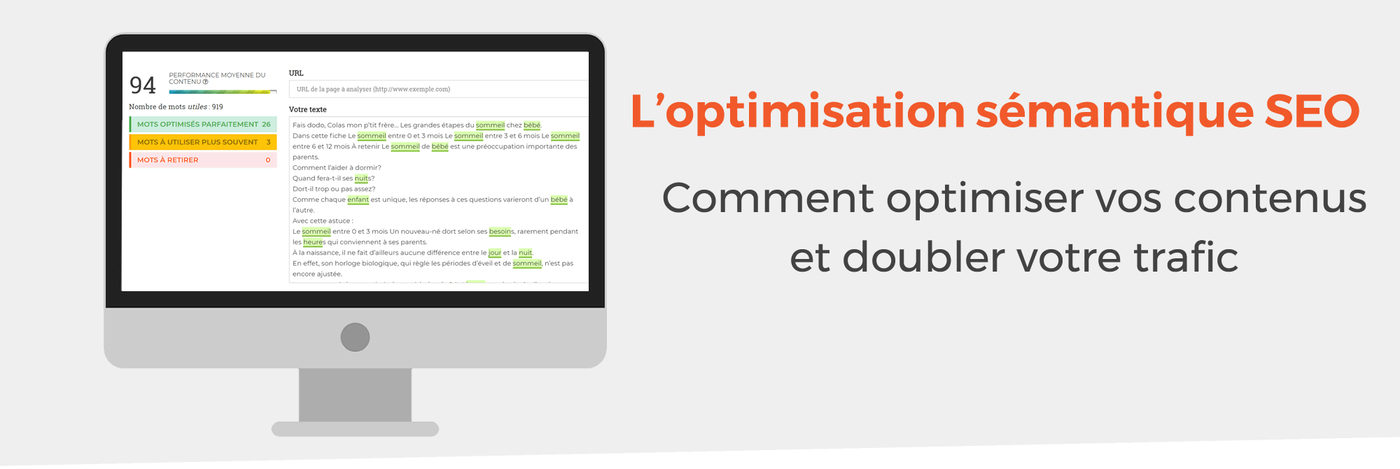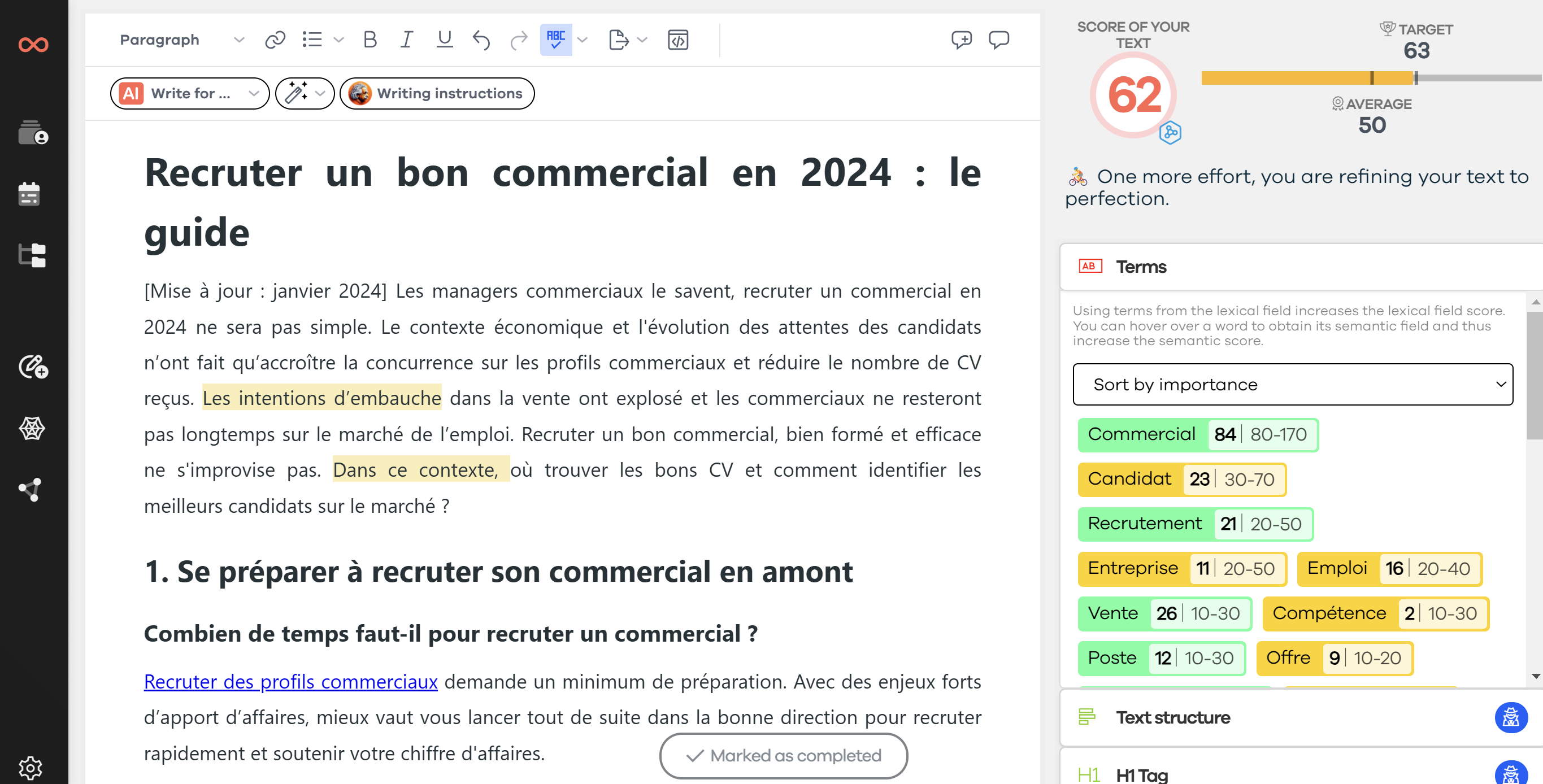Wouldn't it be great if there was a tool that told you exactly which words to use to rank your content in the top 10 results on Google? Good news: SEOQuantum has invented this tool!
Over the past few years, I've been tirelessly working on a game-changing SEO semantic tool: the Content Semantic Optimization Tool. A tool perfectly adapted to market realities and designed to help you improve what matters most to you: your ranking on Google.
This tutorial is a follow-up to the post "Optimizing your SEO with Wordprints". Indeed, it's challenging to determine from the Wordprint the action plan for semantic optimization of your content. This article discusses the "Text Optimization" feature of SEOQuantum.
🤔 How to rank higher on Google?
SEOQuantum's content optimization is an innovative tool that helps you optimize a webpage's content to rank it higher in Google's SERPs.
Using artificial intelligence and semantic algorithms, the tool extracts keywords and topics it recommends using to achieve a good ranking.
If you follow these recommendations, there's a high chance you'll improve the visibility of your pages in search engines.
🚀 Only 3 steps to optimize your content
Over the past few months, I've been working on a complete overhaul of the analysis/optimization tool and an algorithm that would determine the impact of content on rankings. This is how I created the content performance score, which takes into account the specific keywords you need to add to your content and improve your position on Google.
1. Access the semantic optimization tool
To do this, you must have internally launched the semantic analysis step and obtained your Wordprint. Reminder: Wordprints are SEO semantic concepts unique to each of your keywords: it's the "DNA" of your key phrase. It corresponds to Google's "expectations" in terms of semantic field and lexical field.
One keyword = one user intent = one wordprint
Access the content optimization tool from a semantic analysis. You can start optimizing new content or work from existing content or a page. You have two options:
- Directly indicate the URL of the page to optimize (the tool via machine learning attempts to extract only the main content of the page)
- Enter the raw text directly into the "Your text" field
Let's take an example with the targeted query "putting baby to sleep". What I did in the example below is to directly enter the URL of a page for analysis.
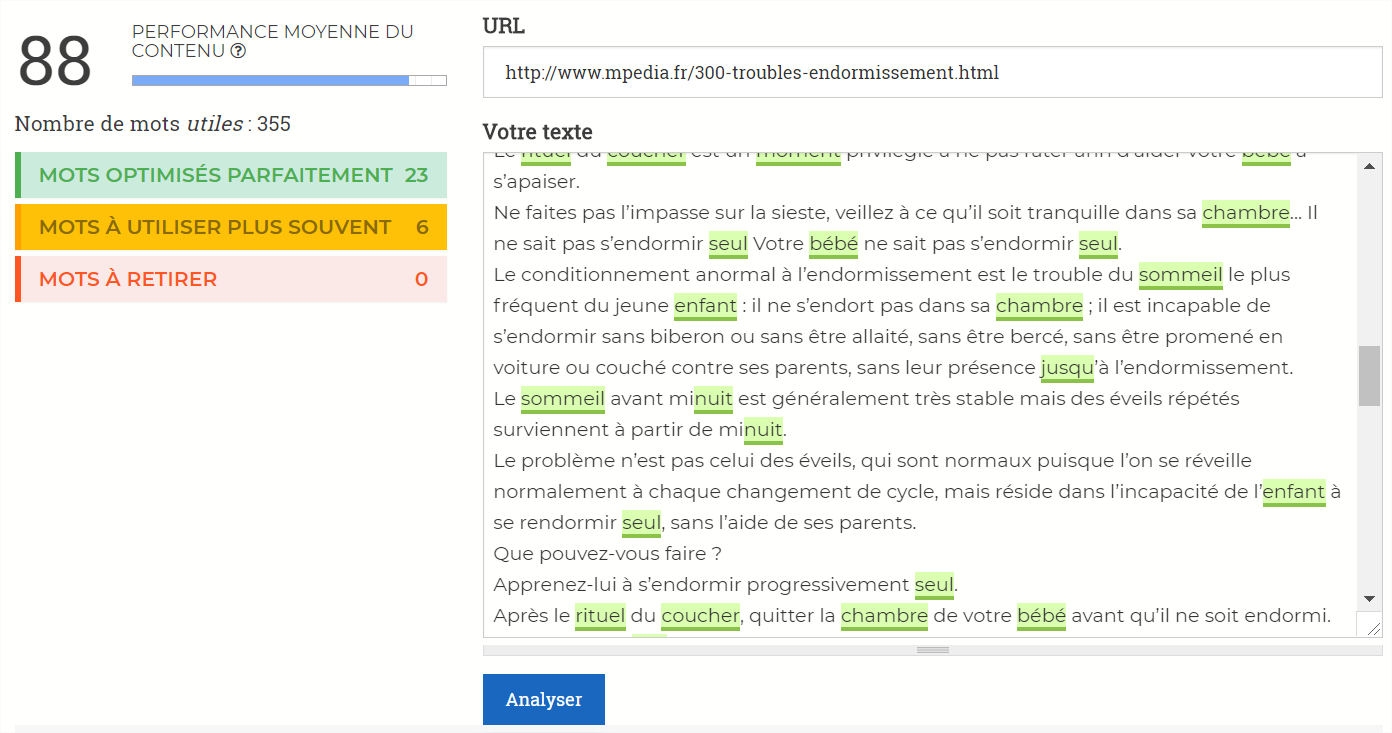
SEOQuantum's semantic analysis tool
2. Make modifications to your page
As you can see in the screenshot below, the tool exactly indicates the optimization status of the content and highlights:
- In green: the words I already use and are perfectly optimized, their densities in the content are good.
- In orange: the words I should use more often in my content.
- In red: in case of keyword stuffing, the tool indicates the words I have used excessively and which can penalize me.
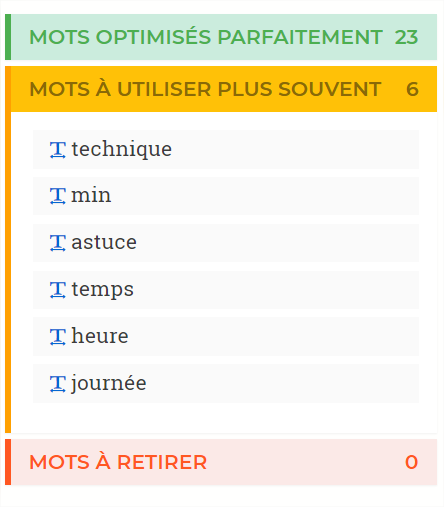
Semantic enrichment proposed by the tool
For a more "practical" side, the tool also offers a statistical table of recommendations.
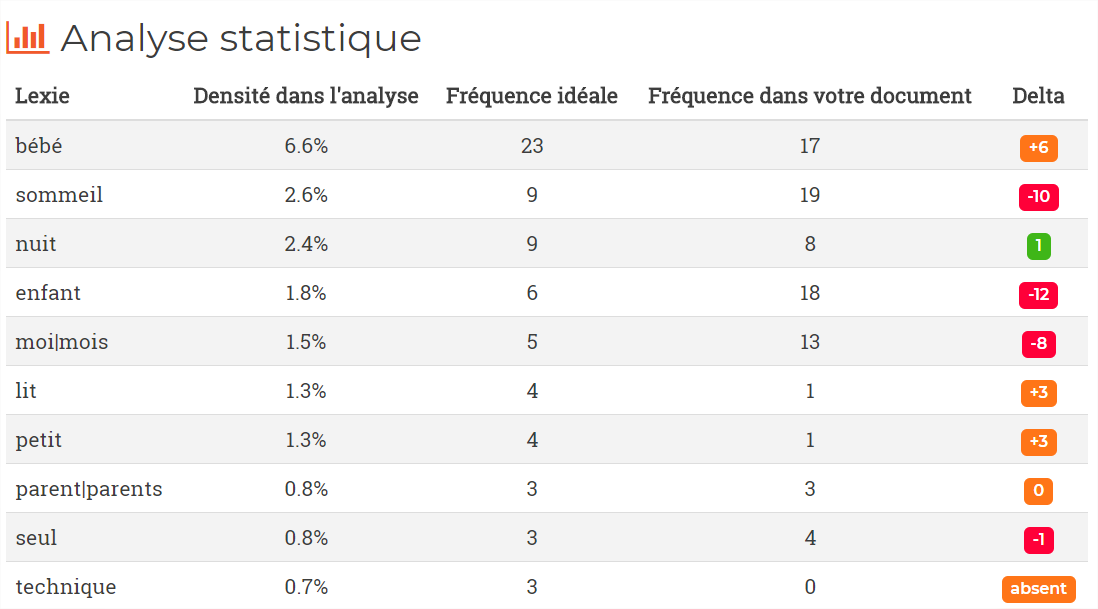
From this table, it's easy for your copywriter to optimize the targeted content.
- **Lexie: term/word studied
- Density in the analysis: the tool is based on semantic analysis to calculate the average appearance value of the lexie
- Ideal frequency for your document: the tool is based on semantic analysis and the length of your content to calculate the frequency (number of times) the word should appear in your document
- Current frequency in your document: Frequency of appearance of the word in the line in your document
- **Delta: Difference between the ideal frequency and your frequency, the delta indicates the action to take (add/remove words)
Note: In SEOQuantum, we talk about "useful words", these are words that bring meaning (semantics) to your sentence. Stopwords (the, a, an...) are not counted.
3. Integrate your content into your topic cluster
The topic cluster is a concept based on your site's architecture, offering you a high-performance and relevant structure for your SEO. Your topic cluster consists of a network of artificial neurons that will extract the main complementary themes, the major semantic concepts that revolve around your main content. The goal is to provide support to the main page by offering other content adapted to the user's query around it.
The topic cluster will be proposed to you in the form of a Treemap, which will offer you a whole bunch of themes/topics/questions that revolve around your main query. This new content will provide support to the theme we are addressing by making it more optimal, more legitimate in the eyes of Google. To concretely understand this concept, feel free to watch my video right here.
Like the topic cluster or silos, there are other methods of content structures in SEO, notably the concept of keyword clustering. The optimization strategy of Keyword Clustering will rely on topics rather than keywords. The topic is at the center of the content. Basically, this keyword clustering model offers web copywriters a relevant and effective content creation, organization, and promotion strategy better suited to information search for website visitors.
By associating content pillars, keyword clustering will allow you to create a centralized content bank that explores all facets of a topic by dividing it into autonomous segments. You can find concrete examples here.
🔎 What is the content performance score?
This metric shows you how much a page or content is optimized on a scale of 0 to 100. The higher the score, the more optimized the content is.
The content performance score is an indicator entirely developed by SEOQuantum. This index combines many algorithms like TF*IDF, BM25, statistical analysis like the number of missing lexies in the corpus, the number of words, but also a semantic note (probability of finding certain lexies in the analysis...).
In short, this engineering concentrate gives you a global score of your content's performance. It's your turn to play now ;)
❓ Does semantic optimization work?
How many times have you written extraordinary content that doesn't rank as you expected? And how many cups of coffee have you drunk trying to understand why other pages rank ahead of you for a keyword?
In recent years, it has become increasingly difficult to rank among Google's top rankings. Yet, we can't stop thinking: what can we do to achieve better positions on Google: should we use more links? Maybe optimize our content to improve quality?
I realized early on that the competition in Google was made up of giants like Wikipedia, but also media like Le Monde, Le Figaro... Difficult, if not impossible, to move them!
**How can small businesses stand a chance against these giants? "Off-page" ranking factors like links are really out of reach. The reputation of these giants is far too significant. And even if that were the case, it's impossible to keep up with the quantity and quality of links that a Wikipedia acquires every day.
I then realized that the solution lies in the "on-site" ranking factors that the webmaster controls: the content.
As I'm always looking for technical solutions for my SEO teams, I started experimenting and measuring early on how Google ranks content optimized by SEOQuantum. Today, I have enough hindsight to answer these two questions that are regularly asked:
Does semantic optimization work? The answer is clearly YES. I talk about it at length through this SEO case study on semantic content optimization.
Another more recent client example is the agency RADIANCE CONSEIL which, following the use of SEOQuantum (semantic analysis and semantic optimization via the tool), managed to rank 1st on the keyword "SEO consultant". Congratulations to Florence for this performance.
⌚ Will it take years to improve my ranking?
1. Gain 1 or 2 places on your keyword
2. Drop in ranking of 10 to 20 places
3. Progression of your ranking towards the final ranking over several weeks
For the entire process, we observe delays of 4 weeks up to 3 months. Following an optimization, in case of modifications on your page (content or tagging), the delays can extend to several months. The keyword is therefore: PATIENCE!
It's your turn! It's time to implement this digital device to optimize your editorial strategy.
Use our semantic analysis tool to, firstly, check the optimization of your existing content. You just need to optimize your texts so that all the lights are green and you see the notification you're looking for: "👏 Great job, your content is ready!".
Once this work is done, you can move on to the next step: write new perfectly optimized web content. But remember, you write primarily for your users, so stay natural and add value above all else.
Need to go further?
If you need to delve deeper into the topic, the editorial team recommends the following 5 contents:
